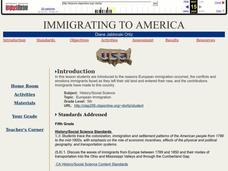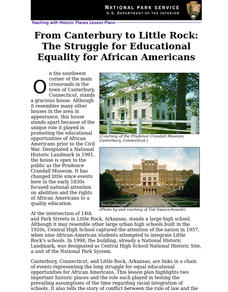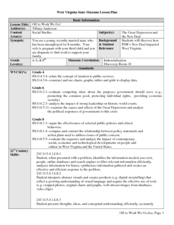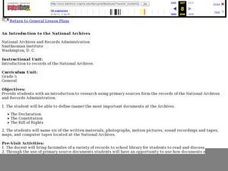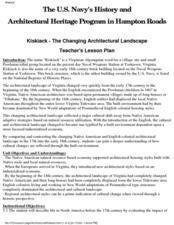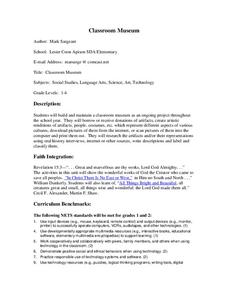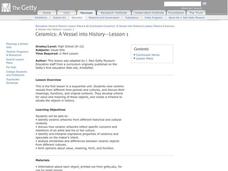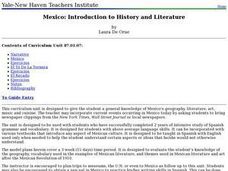Curated OER
Abraham Lincoln and the Arts
Students engage in a study of history and how the figure of Abraham Lincoln has evolved into a national cultural icon. They discuss the importance of his life and how he influenced the political landscape of America in the past and present.
Curated OER
Can you Prove it?
Tenth graders examine how primary source documents help authors and museum curators interpret historic events. In this social studies lesson, 10th graders research primary source documents. Students create a powerpoint to...
Curated OER
Immigrating to America
Coming to America as an immigrant can be an emotional and difficult process. This lesson has learners explore what it means to be an immigrant, listen to real life accounts, and visit an online museum. This is a wonderful discussion...
Curated OER
ART IN COLONIAL AMERICA: PAINTINGS AND CRAFTS
Fourth graders examine art critically and discuss art they have made, art made by their peers, and art made by recognized artists. They add to their art vocabulary and use it accurately to discuss art.
Curated OER
The White House
Fifth graders visit the White House to make connections dealing with the Presidency: Past, Present, and future.
Curated OER
The Surreal Deal
Students examine the art-historical contexts used by Salvador Dali and identify examples of them. They explore surrealism by playing the game Exquisite Corpse, automatic writing or drawing, and dream illustration. They tour the Dali Museum.
Curated OER
Identity of Women in Portraiture
Students look at portraits to learn history. Making connections is done with the identification of details found in the portraits. The gallery depicts the historical times of the Revolutionary War in Colonial America.
Curated OER
Green Transportation System
Consider the effects of green transportation. In this environmental stewardship lesson, determine how transportation has changed throughout history and then collaborate to solve New York City transportation issues.
Curated OER
From Canterbury to Little Rock: The Struggle for Educational Equality for African Americans
Students explain the magnitude of the struggle involved in securing equal educational opportunities for African Americans. They examine how Prudence Crandall challenged the prevailing attitude toward educating African Americans
Curated OER
The People of Kansas: Where Did They Come From and Why Did They Come?
Pupils research and discuss the reasons why early settlers emigrated to Kansas. They, in groups, analyze census district reports from the 1850's and then identify the advantages and disadvantages of using this information as research.
Curated OER
The First Farmers
Students investigate how constant irrigation, with repeated evaporation of water eventually ruined farm land in southern Mesopotamia. They discuss the development of irrigation.
Curated OER
Historic Cemeteries: "History Written in Stone"
Students examine grave markers in their local community. They identify how past generations contributed to life in their town. They discuss their feelings about death and how one is to act at a cemetary.
Curated OER
Finding Friendship
Sixth graders interview community members associated with the lobstering industry. In this interview lesson, 6th graders carry out interview of members of the lobstering community to determine the folklore and workings of the lobster...
Curated OER
Nature, Red in Tooth and Claw
Learners explore the science and art of taxidermy, and research various biomes that could be depicted in museum displays. They synthesize their knowledge by creating dioramas that depict the diverse life forms typical of these biomes.
Curated OER
Off to Work We Go!
Students create a book about The Great Depression in West Virginia. In this West Virginia history lesson, students visit the West Virginia State Museum, answer questions about West Virginia history, and create a book entitled...
Curated OER
An Introduction to the National Archives
Fifth graders study the national archives through both images AND visiting the site. This is meant to provide them with an understanding of what documents are important to the U.S. and why (i.e. Declaration of Independence, etc...).
Curated OER
What's In A Name?
Students create a binomial system of nomenclature for classifying organisms they encounter in a field trip to a natural history museum or from pictures in library books. They work in small groups to create accurate drawings and place...
Curated OER
Kiskiack: Changing Architectural Landscape
High schoolers compare and contrast the changing Native and English colonial architectural landscape of the 17th and 18th centuries. Students research and evaluate how economic technology, and the environment reflected cultural changes...
Curated OER
Ancient Mediterranean Trade Fair
Sixth graders begin the lesson by discussing how artifacts are located. In groups, they define the terms supply, demand, resources and trade and discuss how the United States is affected by International trade. They use this...
Curated OER
Cargoes from Three Continents Ancient Mediterranean Trade
Sixth graders begin the lesson by researching the different types of ships and shipbuilding techniques used to help trade in the Mediterranean Sea. Using different objects, they determine what one can tell about a society and discuss...
Curated OER
American History Through Architectural Masterpieces: Monticello
Students examine the life of Thomas Jefferson, explore great American landmark Monticello, discover relationships between climate, geographical factors, and time as to what kind of architecture was used, conduct research online, write a...
Curated OER
Classroom Museum
Students investigate various aspects of culture. They collect artifacts from various resources as an ongoing project throughout the school year. Students reflect upon the differences in cultures and subject areas as they conduct research...
Curated OER
Ceramics: A Vessel into History
Students view ceramic vessels from different time periods and cultures, and discuss their meanings, functions, and original contexts.
Curated OER
Mexico: Introduction to History and Literature
Students study the geography of Mexico (i.e. major cities, surrounding countries and bodies of water, mountain ranges, rivers, volcanoes), They take turns reading aloud information provided (xerox copies) about Mexico. After each...


